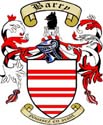
Earl of Barrymore was a title in the Peerage of Ireland. It was created for David Barry, 6th Viscount Buttevant, in 1627/28. [1] Lord Barrymore held the subsidiary titles of Baron Barry (created c. 1261) and Viscount Buttevant (created 1541) in the County of Cork in Ireland. After the death of the 8th Earl in 1823, all these titles became extinct. [2]
Contents
The Barrymore title was revived in 1902 in favour of Sir Arthur Smith-Barry, who was created Baron Barrymore in the Peerage of the United Kingdom. He was the grandson of John Smith Barry, an illegitimate son of James Hugh Smith Barry (died 1837), son of The Hon. John Smith Barry, younger son of The 4th Earl of Barrymore. [3]